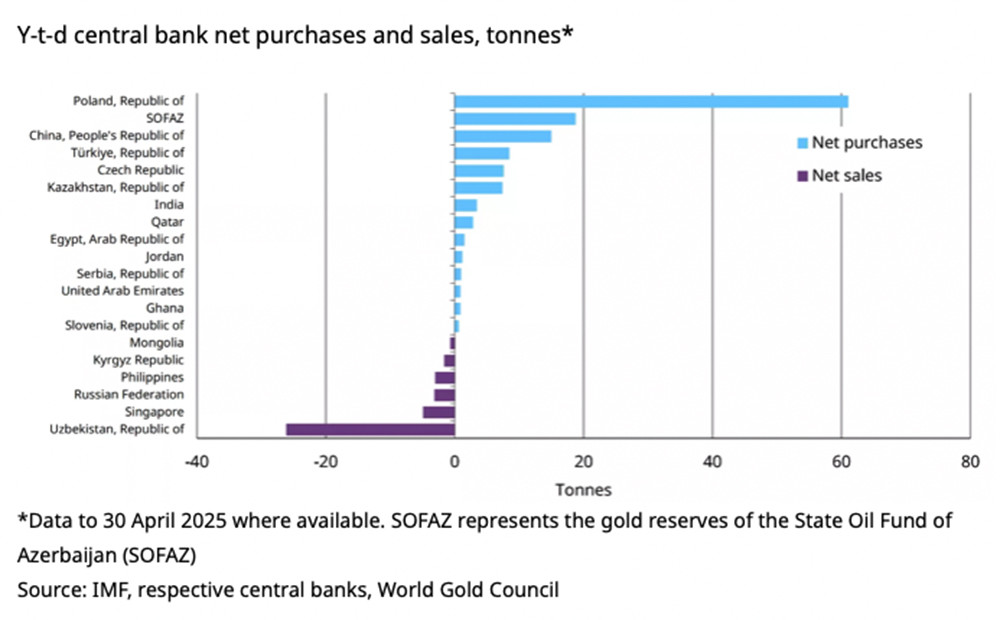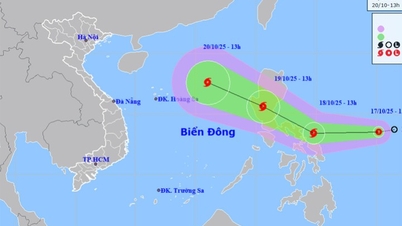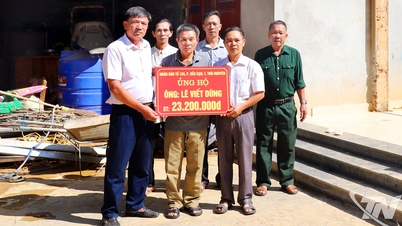Central banks around the world continued the trend of increasing gold reserves in April. Although the pace of purchases decreased compared to previous peak months, the general trend is still increasing gold accumulation in the context of major economies facing inflation, volatile interest rates and geopolitical instability.
Central banks' continued purchases of gold even as prices rise is a complex strategy, based not only on short-term price movements but also on long-term macroeconomic and geopolitical goals.
The National Bank of Poland (NBP) is the largest buyer among central banks. In April, the NBP added 12 tonnes of gold to its reserves, bringing its total to 509 tonnes, surpassing the European Central Bank (507 tonnes). Since the beginning of the year, the NBP has bought a net 61 tonnes of gold, two-thirds of its 2024 target of 90 tonnes.

The Czech National Bank bought another 3 tonnes of gold in April, marking its 26th consecutive month of net purchases. During this period, the Czech Republic bought a total of 47 tonnes of gold, bringing its total holdings to nearly 59 tonnes.
In Asia, the People's Bank of China (PBOC), one of the world's largest gold buyers, increased its reserves by 2 tonnes in April, marking its sixth consecutive month of purchases. Since the beginning of the year, the PBOC has bought a net 15 tonnes, bringing the country's total gold reserves to 2,294 tonnes. The move is aimed at reducing dependence on the US dollar and diversifying assets amid rising trade and geopolitical tensions.
The Central Bank of Türkiye bought another 2 tonnes, bringing total reserves to 626 tonnes.
The National Bank of the Kyrgyz Republic also increased its reserves by 2 tonnes in April, now holding 37 tonnes of gold.
The National Bank of Kazakhstan bought an additional 1 ton of gold, bringing its total reserves to 291 tons, 7 tons higher than at the end of 2024.
The Central Bank of Jordan also increased its reserves by nearly 1 ton, bringing the total to 73 tons.

In Africa, some central banks are also planning to increase their gold reserves. The Bank of Namibia has announced plans to increase the proportion of gold to 3% of total reserves. According to IMF data (March 2019), Namibia does not hold any gold reserves.
The National Bank of Rwanda also plans to build its gold reserves. Governor Soraya Hakuziyaremye said the bank is studying the possibility of including gold as an additional investment asset. She stressed that gold can withstand financial shocks and act as a hedge against global economic volatility. The addition of gold will start from the new financial year in July.
The Bank of Uganda, according to Governor Michael Atingi-Ego, will diversify its reserves with gold sourced from artisanal miners. This gold will be used to settle maturing repurchase agreements.
Madagascar's Central Bank plans to buy 4 tonnes of gold as part of a plan to increase reserves and formalise gold exports.
The Central Bank of Kenya, according to Governor Kamau Thugge, is also actively considering adding gold to its national reserves for diversification purposes. However, no timeline has been set for when this will happen. As of March 2025, Kenya held about 17 kg of gold, according to data reported to the IMF.
Central banks are expected to continue to be key players in the gold market, said Philip Newman, CEO of Metals Focus. Metals Focus forecasts central banks will buy more than 1,000 tonnes of gold this year, for the fourth consecutive year.
“It is difficult to see gold prices not rising when there is strong investment demand supported by central bank buying,” said Mr. Newman.
During times of geopolitical tension, trade conflicts or global economic crises, gold is often seen as a “safe haven”. Demand for gold increases during times of uncertainty, as it retains its value better than other assets during market turmoil.
Source: https://vietnamnet.vn/gia-vang-tang-nong-ca-map-con-manh-tay-gom-vang-2408966.html







![[Photo] Closing ceremony of the 18th Congress of Hanoi Party Committee](https://vphoto.vietnam.vn/thumb/1200x675/vietnam/resource/IMAGE/2025/10/17/1760704850107_ndo_br_1-jpg.webp)



















![[Photo] Nhan Dan Newspaper launches “Fatherland in the Heart: The Concert Film”](https://vphoto.vietnam.vn/thumb/1200x675/vietnam/resource/IMAGE/2025/10/16/1760622132545_thiet-ke-chua-co-ten-36-png.webp)







































































Comment (0)